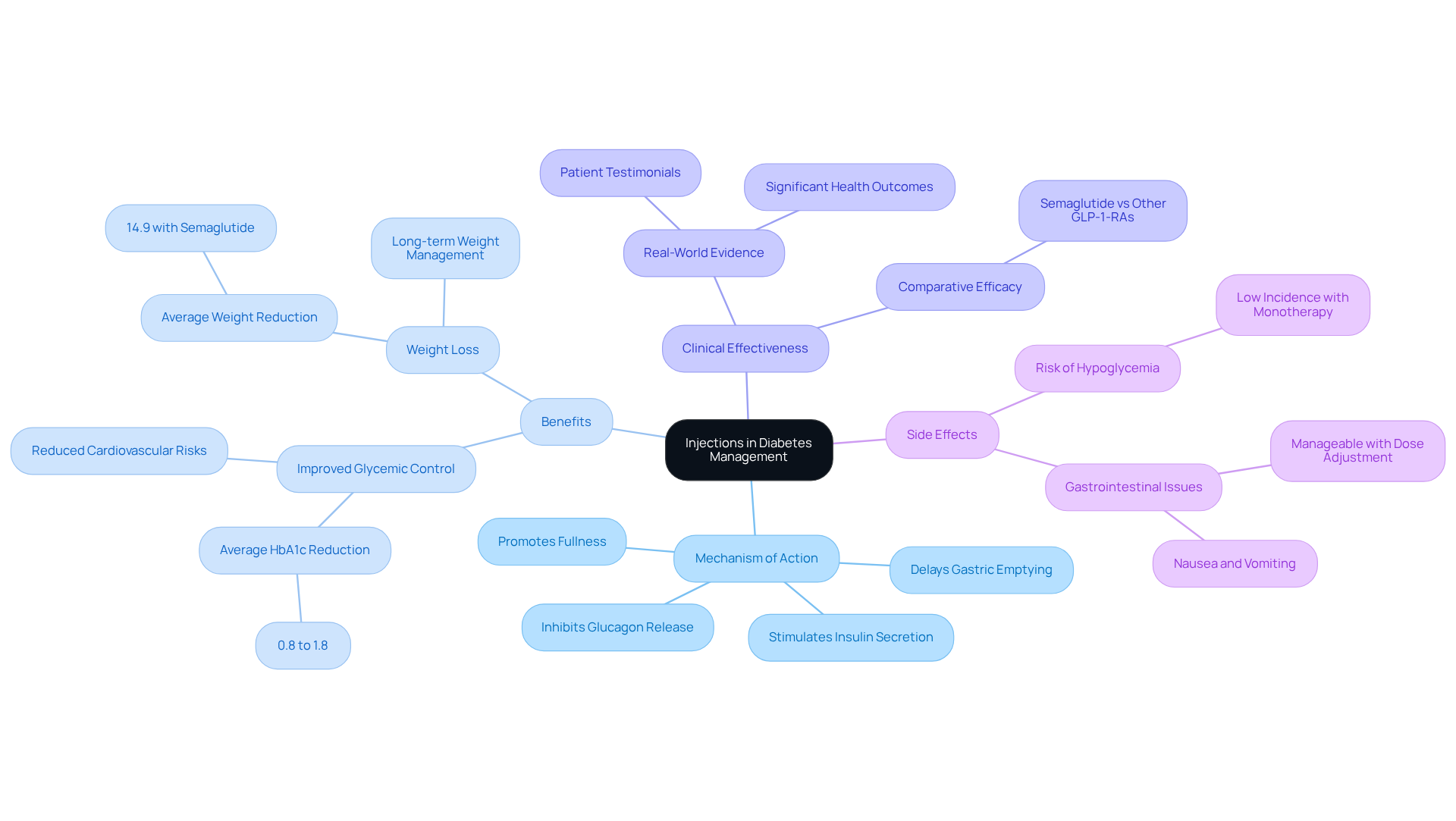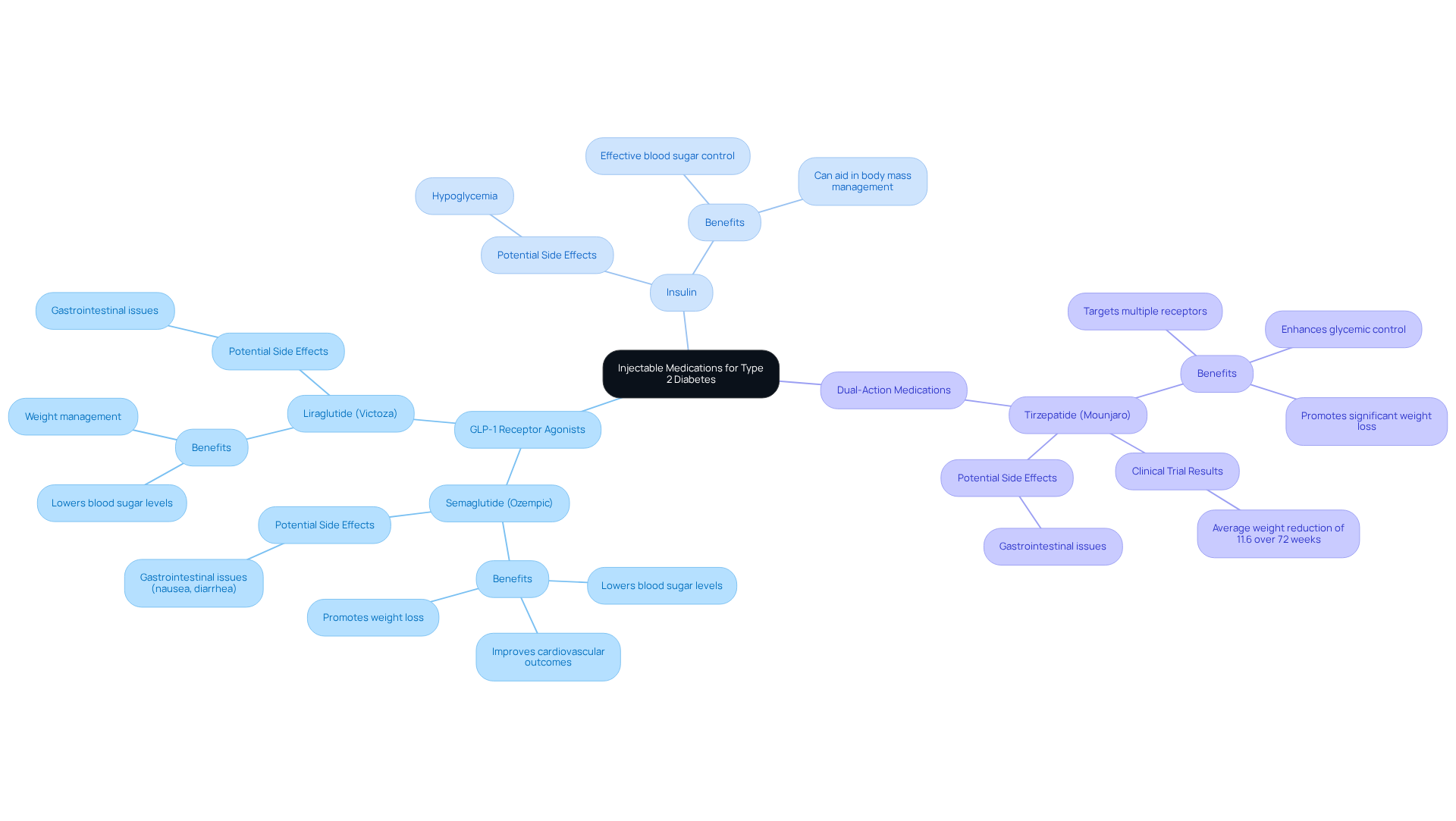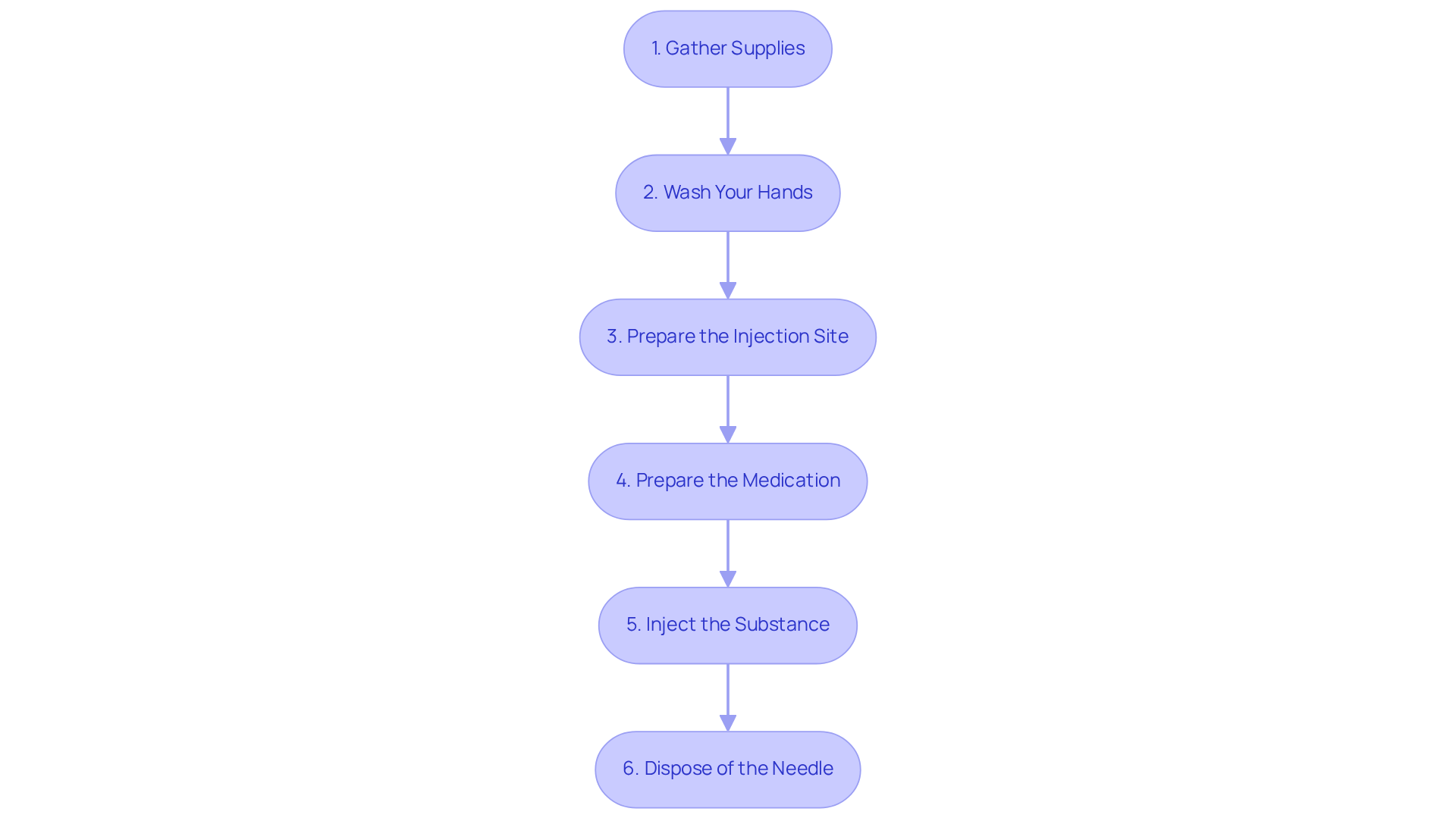Overview
Managing type 2 diabetes can feel overwhelming, but there are effective solutions available. Injectable treatments, particularly GLP-1 receptor agonists, have shown promise in not only managing diabetes but also in promoting safe weight loss. These medications work by improving glycemic control and reducing appetite, which can be a relief for many.
It’s important to recognize that understanding how to properly administer these treatments and being aware of potential side effects can significantly impact your journey. Many patients find that with the right knowledge and support, they can navigate their health challenges more effectively. By focusing on these aspects, we can work together towards better treatment outcomes.
If you’re feeling uncertain about your options, remember that you’re not alone. Many individuals have successfully integrated these treatments into their lives, leading to positive changes. As you consider your next steps, think about how these insights can empower you to take control of your health. The 30-Day Diabetes Reset program offers a supportive path forward, helping you embrace healthier living with confidence.
Introduction
Managing type 2 diabetes can feel overwhelming, and it’s important to recognize that you’re not alone in this journey. Many individuals face similar challenges, and injectable medications have emerged as a powerful ally. These treatments not only help regulate blood sugar levels but also offer significant weight loss benefits, which can be crucial for those dealing with obesity and its associated health risks.
However, the landscape of injectable therapies can be daunting. You might have questions about their safety, effectiveness, and potential side effects. It’s natural to feel uncertain about navigating these complexities. How can you harness the full potential of injection therapy to support your health? By understanding your options and seeking guidance, you can take meaningful steps toward a healthier future.
Understand the Role of Injections in Diabetes Management and Weight Loss
Managing type 2 diabetes can be challenging, and injectable treatments can play a crucial role in this journey, especially when it comes to encouraging weight loss. Medications like GLP-1 receptor agonists mimic hormones that help regulate blood sugar levels and appetite. Understanding how the injection for type 2 diabetes and weight loss works is essential; it empowers you to recognize its potential benefits, such as improved glycemic control and weight loss.
For many, GLP-1 agonists can slow gastric emptying, which leads to increased feelings of fullness and reduced food intake. This effect can be particularly beneficial for those facing obesity or other related health issues. It’s important to recognize that GLP-1 receptor agonists are often recommended as a first-line therapy for individuals with type 2 diabetes who also have cardiovascular risks. This highlights their importance in a comprehensive approach to managing diabetes.
Clinical studies have shown that these medications can lead to an average decrease in HbA1c levels ranging from 0.8% to 1.8%. This provides a tangible measure of their effectiveness. While the benefits are significant, it’s also essential to be aware of potential gastrointestinal side effects. Many individuals experience these side effects, but they are often manageable. This foundational knowledge can empower you to make informed decisions about your treatment options and encourage adherence to your prescribed regimens.
Real-world evidence supports the effectiveness of these injections, with numerous individuals reporting significant weight loss and improved health outcomes. This reinforces the importance of incorporating GLP-1 receptor agonists into your management strategy. Remember, you are not alone in this journey, and understanding your options is a step toward a healthier future.
Explore Available Injectable Medications for Type 2 Diabetes and Weight Loss
Managing type 2 diabetes can be challenging, but a variety of injectable medications are available to support you on this journey, each with its unique mechanisms and benefits:
-
GLP-1 Receptor Agonists: Medications like Semaglutide (Ozempic) and Liraglutide (Victoza) are designed not only to lower blood sugar levels but also to promote weight loss. They work by increasing insulin release and reducing appetite, making them effective options for those looking to manage both diabetes and body mass. It’s important to recognize that while these medications can be beneficial, they may also cause gastrointestinal side effects, such as nausea and diarrhea, especially when you first start them.
-
Insulin: Traditionally used for blood sugar control, certain insulin formulations can also help manage body mass when used correctly. This dual benefit can be particularly helpful for individuals facing challenges with body mass alongside their diabetes.
-
Dual-Action Medications: Newer options like Tirzepatide (Mounjaro) represent a significant advancement in blood sugar management. By targeting multiple receptors, Tirzepatide serves as an effective injection for type 2 diabetes and weight loss, enhancing glycemic control and promoting weight loss in a comprehensive approach to managing the condition. Clinical trials have shown that participants using Tirzepatide experienced an average weight reduction of 11.6% over 72 weeks, which is quite encouraging.
Comparative analyses reveal that GLP-1 receptor agonists, especially Semaglutide and Liraglutide, consistently lead to significant fat loss while preserving lean mass. This preservation is crucial for maintaining your overall health and metabolic function.
Healthcare specialists emphasize the effectiveness of these medications, noting that GLP-1 receptor agonists not only improve glycemic control but also yield better cardiovascular outcomes. For instance, Semaglutide has been linked to a 20% reduction in nonfatal myocardial infarction and stroke, underscoring its importance in diabetes therapy.
Furthermore, Dr. Shumard’s center offers valuable educational resources, including books and seminars, to empower individuals with knowledge about their conditions and treatment options. Understanding the unique characteristics and indications of each injectable medication, such as the injection for type 2 diabetes and weight loss, allows you to engage in informed discussions with your healthcare provider, ensuring you select the most effective treatment tailored to your needs. The center’s 30-Day Diabetes Reset program further supports this mission by equipping you with the necessary tools and knowledge to transform your health.
As you navigate this journey, remember that you are not alone. Many patients find that having access to supportive resources and a caring community makes a significant difference in managing their diabetes effectively.
Follow Step-by-Step Instructions for Safe Injection Administration
To safely administer injectable medications, it’s essential to follow these step-by-step instructions with care:
- Gather Supplies: Start by ensuring you have your medicine, syringe or pen, alcohol swabs, and a sharps container ready. This preparation can help ease any anxiety you may feel.
- Wash Your Hands: Take a moment to clean your hands thoroughly with soap and water. This simple act is crucial in preventing infection and shows your commitment to safety.
- Prepare the Injection Site: Choose a suitable injection site, such as your abdomen or thigh, and gently clean it with an alcohol swab. Remember, it’s important to recognize that a clean site can make the process smoother.
- Prepare the Medication: If you are using a vial, draw the prescribed dose into the syringe carefully. If you prefer a pen, follow the manufacturer’s instructions to set the dose accurately. Many patients find that taking their time here helps reduce stress.
- Inject the Substance: Pinch the skin around the injection site, insert the needle at a 90-degree angle, and gently push the plunger to administer the substance. It’s okay to feel a bit nervous; you’re doing a great job by following these steps.
- Dispose of the Needle: After the injection, safely dispose of the needle in a sharps container. If necessary, apply a bandage to the site. This final step is vital in ensuring your safety.
By following these steps, you can administer injections correctly, which minimizes discomfort and maximizes the effectiveness of your treatment. Remember, you are not alone in this journey; reaching out for support can make all the difference.
Recognize Side Effects and Troubleshoot Common Injection Issues
While injectable treatments can be highly effective, it’s important to recognize that they may also lead to side effects. Many patients experience common side effects, such as:
- Nausea: This is often experienced with GLP-1 agonists. You can manage this by starting with a lower dose and gradually increasing it, which many find helpful.
- Injection Site Reactions: Redness, swelling, or itching at the injection site can occur. Rotating injection sites can help minimize these reactions, making the process more comfortable.
- Hypoglycemia: Low blood sugar can result from insulin or specific drugs. It’s crucial to monitor your blood sugar levels regularly and have a source of fast-acting glucose available, just in case.
If you encounter issues, such as difficulty injecting or persistent side effects, please consult your healthcare provider for guidance. They are there to support you and may adjust your dosage or suggest alternative medications to enhance your treatment experience. Remember, you’re not alone in this journey, and seeking help is a positive step toward your health.
Conclusion
Injectable treatments for type 2 diabetes not only play a pivotal role in managing blood sugar levels but also significantly contribute to weight loss efforts. It’s important to recognize that understanding the mechanisms behind these injections, such as GLP-1 receptor agonists, can empower individuals to harness their benefits for improved health outcomes. Throughout this guide, we’ve emphasized the importance of selecting the right medication and adhering to safe injection practices, ultimately leading to a more empowered approach to diabetes management.
Many patients find that knowing the variety of injectable medications available and their unique benefits can make a significant difference. Proper administration techniques are crucial, and the insights provided showcase the potential for achieving meaningful weight loss and better glycemic control. Moreover, recognizing and managing side effects ensures a smoother treatment experience, allowing patients to remain engaged and proactive in their health journeys.
In summary, the journey to managing type 2 diabetes and achieving weight loss can be significantly enhanced through the informed use of injectable therapies. Embracing these options, understanding their benefits, and committing to safe administration can transform the experience of living with diabetes. It is crucial to consult healthcare providers for personalized guidance and to actively participate in support networks, fostering a community that encourages shared experiences and knowledge. Taking these steps not only aids in effective diabetes management but also paves the way for a healthier future.
Frequently Asked Questions
What is the role of injections in managing type 2 diabetes?
Injections, particularly GLP-1 receptor agonists, play a crucial role in managing type 2 diabetes by mimicking hormones that help regulate blood sugar levels and appetite, which can lead to improved glycemic control and weight loss.
How do GLP-1 receptor agonists help with weight loss?
GLP-1 receptor agonists slow gastric emptying, leading to increased feelings of fullness and reduced food intake, which can be beneficial for individuals facing obesity or related health issues.
Who is typically recommended to use GLP-1 receptor agonists?
GLP-1 receptor agonists are often recommended as a first-line therapy for individuals with type 2 diabetes who also have cardiovascular risks.
What is the average decrease in HbA1c levels with GLP-1 receptor agonists?
Clinical studies have shown that GLP-1 receptor agonists can lead to an average decrease in HbA1c levels ranging from 0.8% to 1.8%.
Are there any side effects associated with GLP-1 receptor agonists?
Yes, potential gastrointestinal side effects are common among individuals using GLP-1 receptor agonists, but they are often manageable.
What evidence supports the effectiveness of GLP-1 receptor agonists?
Real-world evidence indicates that many individuals using these injections report significant weight loss and improved health outcomes, reinforcing their effectiveness in diabetes management.
How can understanding GLP-1 receptor agonists empower patients?
Understanding how these injections work can empower patients to make informed decisions about their treatment options and encourage adherence to prescribed regimens.



